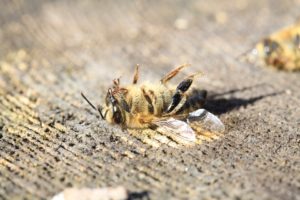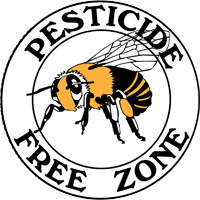 Are bees endangered because of the use of pesticides which are used on many crops?
Are bees endangered because of the use of pesticides which are used on many crops?
Recent research states that 30% of the French bee colonies died in the winter of 2017-2018 while US beekeepers lost 33% of bees in 2016-17!!
In recent winters, in Europe alone, bee losses up to 53% became a reality.
There are some pesticides that kill the bees directly. This occurs when bees are on the flowers at the time of application of the insecticide or pesticide and the bees die instantly. Some other types of pesticides allow the bees to return home and then they die. There are certain pesticides that do not have any effect on the adult honey bees but cause damage to young, immature bees.
Exposure to agricultural pesticides called ‘neonicotinoids’ has been linked to ‘large-scale population extinctions’ in the bee populations.
The neonicotinoids are a relatively new class of pesticides that have an effect on the bee’s central nervous system. It is the most widely used insecticide in the US, which is used as a coating in agricultural seeds and in potted plants. It spreads to the whole plant including pollen and nectar that the bees eat. Scientific studies indicate that the bees that feed on neonicotinoid contaminated pollen and nectar forage less and produces fewer offspring. The other insecticide, coumaphos, is a compound that is used in a honey bee hive to kill a parasite called the Varroa mite that commonly attacks honey bees.
The combined effect of these two pesticides was far greater than individual effect.
Recent news reported were as follows:
Fipronil blamed for historical bee deaths
Scientists urge regulators to consider bioaccumulation when approving new pesticide uses
By Britt E. Erickson │December 3, 2018
Researchers in the UK report new evidence that the pesticide fipronil, not the neonicotinoid imidacloprid, caused a massive die-off of honey bees in France from 1994 to 1998. Both pesticides hit the market in the early 1990s.
The researchers determined that bees rapidly eliminate imidacloprid from their bodies, but they bioaccumulate fipronil. So over time, after prolonged exposure, fipronil becomes more lethal to them. Fipronil is associated with kidney, liver, and thyroid problems in humans.
More than 700 North American Bee Species Are Headed Toward Extinction
By Justin Worland │ March 2, 2017
Population levels of more than 700 North American bee species are declining as habitat loss and pesticide use continue at a breakneck pace, according to a new report.
The report from the Center for Biological Diversity relies on an evaluation of more than 1,400 bee species with sufficient data for the assessment. More than half of those species are on the decline and nearly a quarter is at risk of extinction, according to the report.
The study joins a growing body of research sounding the alarm on the threats facing bees. A 2015 report from a United Nations group found that populations are declining for 37% of bee species, with 9% of butterfly and bee populations facing extinction.
The evidence is clear: pesticides kill bees.
We at C Tech Corporation have a unique, effective, and efficient way to tackle these pesticides and replace them with the pest repellent products that we manufacture.
The unique product CombirepelTM manufactured by C Tech Corporation is an insect, animal, and bird aversive which repels the pests.
CombirepelTM works on the mechanism of repellency. It is an extremely low concern, low toxic, low hazard, non-carcinogenic and non-mutagenic pest aversive. It does not kill or cause harm to the pests as well as to the environment which indirectly helps to maintain the ecological balance.
CombirepelTM is available in the form of the masterbatch, which can be incorporated into the polymeric applications like pipes, agriculture mulch films, floating row covers, greenhouse films etc. used for crop cultivation purpose.

The product available in the form of liquid concentrate can be mixed in paints in a predetermined ratio and be applied to the fences in the garden and farms to keep the pests away from these places. It can also be applied to the warehouse structures where the cultivated crops, equipment are stored.
Our product in the lacquer form can be applied topically on the applications. The lacquer is compatible with most of the surfaces like wood, concrete, metal, polymer, ceramic, etc. The lacquer can be applied on the already installed pipes in the fields or garden, fences around farms and garden, walls of the warehouses where the agricultural produce are stored, thus protecting it from damage.
Our newly developed product in the form of a spray can be sprayed anywhere to repel the pests. The product is compatible with all types of surfaces and can be used by anyone. The CombirepelTM pest repellent spray is safe for use in farms and warehouses.
CombirepelTM is thermally stable and does not degrade on exposure to heat and sunlight. It does not kill or harm the insect but repels them. It does not volatilize and does not degrade the soil. It is RoHS, RoHS2, EU – BPR, ISO, REACH, APVMA, NEA compliant and FIFRA exempted.
 Contact us at
Contact us at
technical.marketing@ctechcorporation.com to keep the pests away and decrease the use of pesticides and thereby contribute towards protecting the bees.
Also, visit our websites:
http://www.ctechcorporation.com/
http://www.rodrepel.com/
http://www.termirepel.com/
http://www.combirepel.com/
Follow our Facebook pages at:
1] https://www.facebook.com/Combirepel-411710912249274/
2] https://www.facebook.com/Termirepel-104225413091251/
3] https://www.facebook.com/Rodrepel-120734974768048/
Follow us on our Twitter pages at:
1] https://twitter.com/rodrepel
2] https://twitter.com/termirepel
3] https://twitter.com/combirepel
